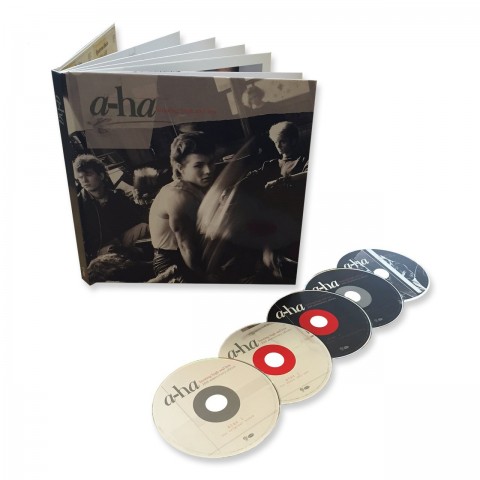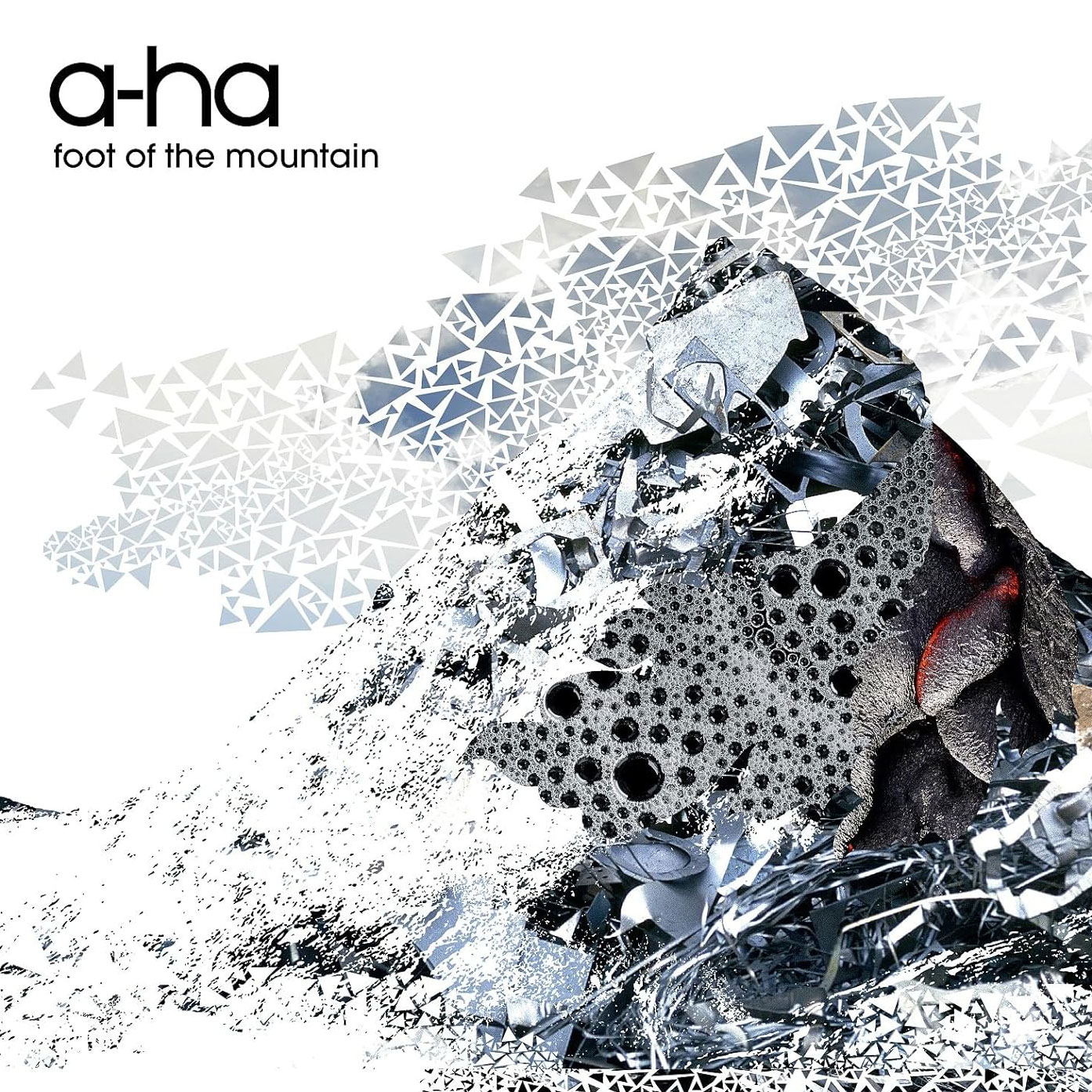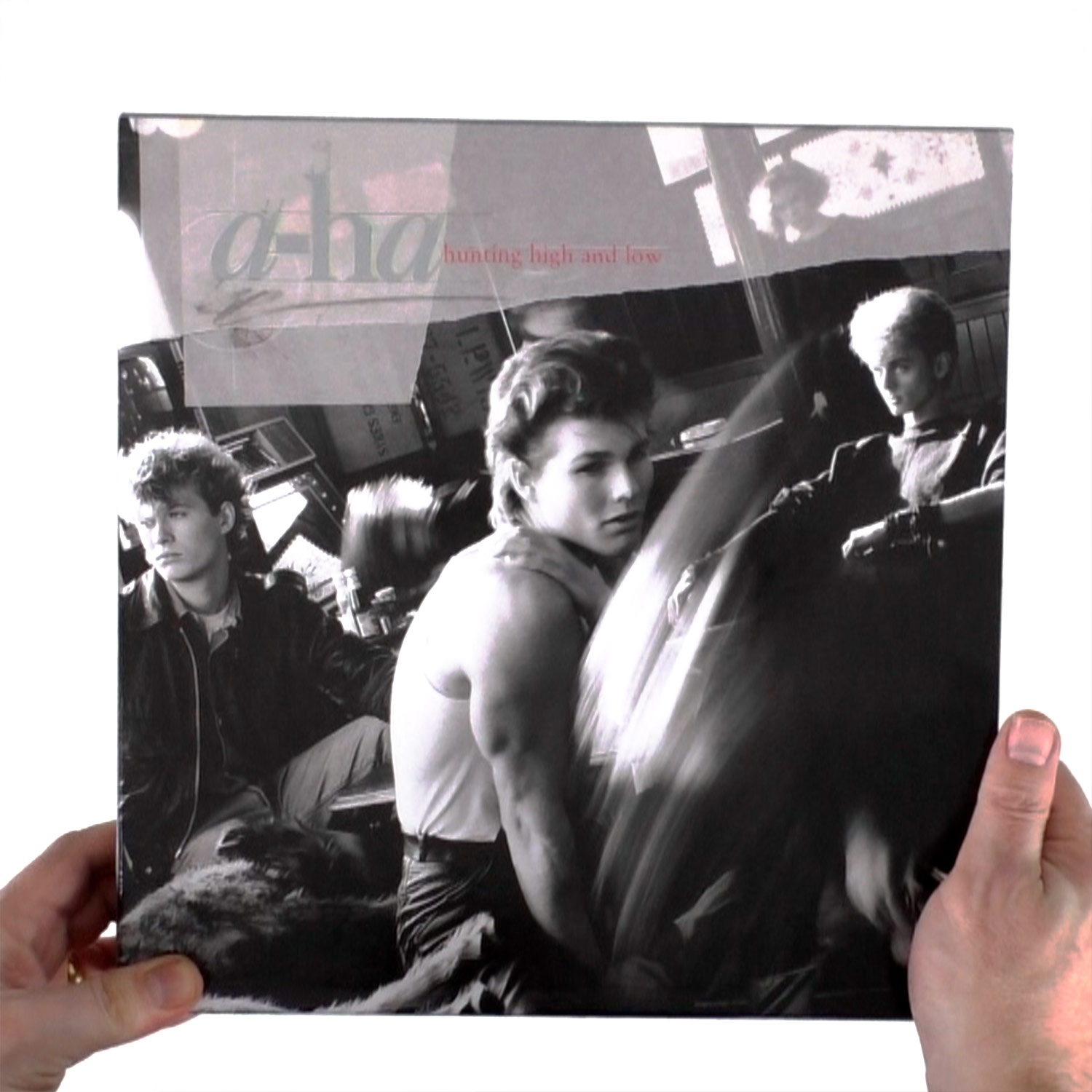Bill Inglot on reissuing a-ha
Bill Inglot is an American music engineer and reissue producer who has a reputation for excellence. He has been in the business for over 30 years and for a long period he was employed by Warner Music / Rhino, working on numerous projects including The Monkees, Roy Orbison, the Bee Gees, Pretenders, and the Ramones.
Now an independent consultant, Bill has worked on many a-ha archival sets including The Singles 1984-2004 compilation, the 25 set from 2010 and the deluxe reissues of Hunting High and Low and Scoundrel Days (also issued in 2010). SDE talked to Bill recently about the new super deluxe edition of the Hunting High and Low album and his philosophy in terms of reissues and remastering. You can read the full interview below…
SuperDeluxeEdition: When did your personal appreciation of a-ha’s music start?
Bill Inglot: I first became aware of the band because when I first started working for Rhino, I was attached to a mastering studio in the States that did work for Warner Bros. The short version [of the story] is one night a call comes in, everyone had to stay late because there was a courier coming from the airport and they needed to get some cassettes run off of something that was coming in from the UK that was a new release. So I wasn’t involved, I was just working at the studio on stuff for Rhino. But anyway, the tape that came via Air Express courier was the album master for Hunting High and Low, which no one had heard, because the thing with a-ha was they were signed to an American deal, and what I think a lot of people don’t sort of grasp is that even though they were from Norway and A&R’d out of the UK office, Burbank takes them over out of interest…
SDE: How did that happen though? How did they end up being signed in America when all the interest was in the UK?
BI: Essentially they have a UK manager that then becomes a co-manager, but the gentleman who became their prime manager, Terry Slater, I’m going to make the assumption that he had deeper connections with the Burbank office, which was the mothership for Warner Bros. If you were trying to have worldwide success, you were going to need money behind it and there was going to be more money from the mothership than from the satellite. Obviously, Warners worldwide with the mothership at that time was the Burbank office. So anyway, I was working at the studio and the tapes came in so they could cut some acetates and make some cassettes to get over to Burbank by the morning. This was in Hollywood. So the interesting thing is I’m probably one of the first people in the States to actually hear Take On Me, before it was released, before, literally, it was even heard by anyone in a finished form anyway, by anyone in Burbank. So I did have them run off a cassette for me, and [drily] I didn’t post it on the internet because there was no internet at that time…
So really at that point I became a huge fan of the band, and continued to follow them after the slope-off of their popularity in the States. I was still a voracious record collector so I was still tracking down what would have at the time been import releases on the 12-inches and seven-inches. I mean the albums came out, so that was easy to follow.
SDE: When you heard that cassette, the original tape of Hunting High And Low, did you think “they’re going to have some smash hit singles”, “they’re going to be massive”? What was your take on it?
BI: Well I mean it was something that seemed to take some of those elements at the time – with the synths and the drums, and the sound and the feel – and turn it into something. When I was listening to it and playing it for friends, it was sort of [regarded as] a mature version of synth pop in the sense that their drums were programmed, but they didn’t sound like it. It sounded like a drummer playing. You had a band that was largely keyboard driven, but the guitar player was the prime songwriter. It’s like anything, I think it’s hard to put your finger on it, but I really felt that Take On Me was going to be a hit. Talking to people over the years, is there seems to be a real appreciation for that album – it really is kind of a landmark record. But you usually don’t see it listed as someone’s landmark record. I mean, I think that the band’s inability to get a larger foothold in the States, I think was a bit unfortunate, because I certainly think that they carried on with records that were equally as strong. I can almost make a case that Scoundrel Days is the equal of Hunting High and Low.
SDE: The band kind of dropped off a cliff, commercially, in the States, whereas their success in Europe was reasonably sustained. What was your take on that? Were they just hard to pigeonhole, maybe, for US radio?
BI: Well, I think that it’s….and this is all supposition….I mean the story I always heard was that MTV lost interest, where [previously] they loved them – MTV didn’t add the video of I’ve Been Losing You to regular play, and at that point it was kind of game over. Plus, I mean you had the classic thing too, that in the pre-internet days, if you wanted to be known in the States, you had to get on the tour bus and you had to get on the tour bus often. As always, I think a lot of these things, it’s the sum of the parts as they say, and I think you could have another issue too, where you have a band that signed to an American deal but maybe didn’t have an absolute champion in the Burbank office. So you’ve got a Norwegian band being A&R’d out of London, signed to an American deal. So it’s that sort of separation, plus you have that inevitable thing a lot of the times of just fate. Why didn’t Big Star have platinum albums? It’s just that type of thing.
SDE: When did you start to work with the band professionally?
BI: I got involved with the band initially when they played their first set of ‘comeback’ shows, if that’s the right way to put it, that would be around 2000. I went to Oslo to see them play – the thing I always tell people, it’s like there’s clubs I can walk to here in Silver Lake that I haven’t been to, but I’ll think nothing of flying 8,000 miles to see a band play.
And at that point a gentleman named Fred Engh, who was one of the Warner people in the Norway office, was kind enough to introduce me to the band, so I met them at the show. Then about two years later, because of the relationship with Fred, I put together a package called Singles that was a hits record, and that came out worldwide, except for the States. I basically gathered up all the tapes, because at that point, physically, most things were stored in the UK, so I was getting stuff shipped over to verify and make sure that the original masters and the proper singles sources were used. And Jeri Heiden, who did the artwork for the original Warners albums, I got her back involved in doing the sleeve art. The sets that we did in 2010 were several years in the making in the sense of trying to get everybody interested in putting them out.
And we worked on 25, I saw several shows on that tour that year. I began working with their manager Harald Wiik, who’s been very cooperative and the band’s been very cooperative. I have to say they’ve been more than generous with their time and with their cooperation and their enthusiasm to let some of these things – which you can argue are ‘baby pictures’ – come out, which isn’t always the case. I was telling someone about this the other day, I mean you have a band that – keeping the discussion to the first Warners era – had five records with give or take, 50 to 60 tracks that were originally issued, and between the deluxe editions we’ve done and the ones that are going to be coming out soon, we’ve put out probably close to 100 unissued tracks, and I define ‘track’ obviously it can be an alternate version demo and not necessarily 100 unheard songs, but pretty phenomenal for a band that pretty much had, over the arc of their career, literally at that point a handful of non-LP tracks.
SDE: As you say, you did the 2010 version of Hunting High and Low. Did Warners come to you with an idea of doing this bigger box five years down the line, and did that surprise you that they might want to tackle it a second time?
BI: Well, we had talked about, when we did the records in 2010, the follow-on was always to try and carry on and do what I keep calling ‘the other three’ [Stay On These Roads, East of the Sun West of the Moon and Memorial Beach]. So some development was done on those at the time, and when some of the things started to happen with the current state of the band, it was one of those ideas that was just sort of kicked around, and we hit on the idea of doing this, you know, as always, people love the anniversaries with the fives and the zeros at the end. So there was just some interest and we felt that we could do something with it, but if we were going to go down that road, it had to be about making a very nice package. We had, I thought, done a fairly thorough job with the 2010 set, so it wasn’t like we were holding stuff back saying “oh yeah, we’re going to do another one in five years”.
SDE: It was very comprehensive, the 2010 set…
BI: This [new] one, obviously it’s more of a keepsake in terms of it being a hardbound book. We went a little bit deeper in terms of putting some things on, some alternate mixes that were done originally that within the landscape of two discs, weren’t going to get shortlisted. And I wanted to get something out on the DVD definitively – you know, try and get the best looking versions of those videos that we could, which is actually, it’s a fascinating thing. It’s certainly as difficult, if not more difficult to get videos from that period looking good, because of the fact that the original intention of those things, as always, was never to be some sort of permanent artefact, but it was just to get something shown on broadcast television. So trying to find a video master that is close to the original source is more difficult than one might think. So it’s been an interesting experience for me working on the video end and trying to get things the best that they can be.
SDE: Do you think it’s important to have the videos included, because I know some labels I’ve talked to about re-issues, they just think “it’s all up on YouTube” and can’t be bothered with the videos. What’s your thoughts on that?
BI: Working in the video realm is expensive. I mean in a perfect world would you like to put together some video clips, where you’re licensing stuff from the BBC or from wherever, but those are the things you really can’t do anymore because of YouTube, because the licensing issues haven’t got any less complex just because they’re out there in the ether, unfortunately, and it has taken away a lot of the interest, so you’re not seeing people doing video compilations anymore, which you saw somewhat more in the pre-YouTube days. So I’d say that like most things, the path you take is can you do something that’s a quality project, but you can bring it in at a costing that makes sense, but at the same time is going to be something that you’re going to be happy to have your name on, as well as the artist? I mean really, ultimately that’s, in my mind that’s always who I’m trying to represent when we put a package together.
So I thought for this set, because the video is so iconic, that it was good to have the video in there, and we have a slightly different cut of Take On Me that we found, so there’s an alternate, when I say alternate, it has different edit points in it and there are some different images. It’s not a completely different video.
SDE: Did you consider putting any extra audio on the DVD, like maybe a high resolution stereo of the album, or a 5.1 or anything like that?
BI: Well it was discussed. I mean the 5.1 brings an issue that you run into a lot of the times, [and that is] is not necessarily having all the elements in order to be able to do it. With a lot of bands from that period, it’s not like you have every single multitrack source just sitting in a row, I’ll have that, I’ll have that, I’ll have that… And the thing is if you have an album with 12 songs on it but you don’t have the multi-tracks on three, it’s kind of a buzzkill to me, because although the technology has come a long way, I’m not necessarily a big fan of the extraction mixes. So it was talked about and the feeling was that we’ll leave the hi-res to the hi-res aggregators. I wanted to have the videos be as uncompromised with video compression as possible.
SDE: So what was the source of the videos? Did you track down old one-inch reels and things like that? Where did they come from?
BI: They came from everywhere. At that point in time, 1985-ish, the currency of the realm was still that they were edited to video even if you had something that was shot on film, or shot on film and shot on video. And we pulled in, I pulled in broadcast copies, I pulled in things that were labelled as ‘the master’. The other thing you have a problem with at times is there are different video formats, so was it cut on PAL? Is the master the NTSC version or is the PAL master the version?
So have to get a lot of things into the room and you really have to look at them, because very often if something is, you’re holding an element in your hand and it says ‘master’ on it, well first thing you always have to ask yourself is master for what? Whose master is it? When you say “I’m giving a master to MTV”, well yes it is, but it’s actually a copy and a conversion of the final edited master, but it might have a nice little sticker on it that says it’s the ‘master’. Well that doesn’t mean it’s the master, master.
The best thing to do is to try and get everything into a room and start physically looking at the boxes and sorting them out, looking at dates, looking at this. I mean obviously if you have something that’s dated 1991 and it’s got a sticker on it but it’s a video from 1986, well that probably isn’t your master. But there’s no substitute for your eyes, looking at it and saying well that looks great or I can see this one has a little more resolution or is cropped differently, or what have you.
SDE: So were you relatively pleased then, in the end, with what you got together?
BI: Yeah. I mean as always, you wish you could go back in time and say “oh gee, if they’d only done it this way”, but you know, I mean I have the discussion with people all the time. It’s like when people were trying to get records out then, and it’s not really that much different now. You’re thinking about the moment. You’re not thinking about, well in 30 years from now we’re going to have to do this in a different way, because you may not have a career for 30 minutes, let alone 30 years, so you’ve got to work with what you have in front of you at the time and give it your best shot.
SDE: The new Hunting High and Low super deluxe is labelled as a 2015 re-master, but I’m assuming there’s not really going to be a hell of a lot of difference between this and the previous set?
BI: Well our tape work, like any of the things that we work on, it’s sort of never done. It’s like if I have unanswered questions from a project that I worked on five years ago, I’ll probably keep answering them. So there were some changes in some of the sources. As I always say, I never try to be somebody who out-tasks myself or the work we do. There’s some things that were improved a bit. I was able to find some tapes that I hadn’t found in the past, because with these things, you’re kind of never done. When you have a group that has a worldwide stance and they’re signed to a multinational record company, you’re going to have things that are going to end up in a storage facility here or there.
SDE: Does that mean you went through a process, track-by-track, of thinking “do we have a better source for this one, yes or no?” If no, then we’ll make do with the digital transfer from 2010, or if yes, then we’ll dig out that reel and go through the process of digitising it and remastering from the digital file. Was that roughly the approach?
BI: Well it depends on the record. I mean a chunk of Hunting High and Low is recorded on analogue, but it was also the early makings of a digital mixing and some digital recording. So for Hunting High and Low, there was a cutting master made to make the vinyl, because it was still a vinyl era record – it’s kind of literally at that crossover point. But the masters for all of the songs were a stack of tapes in various formats.
I tend to do this a lot if I can have the ability to do it, which is basically sort of rebuilding the master, because what may have made that record in 1985 might have been a 30IPS half-inch analogue tape, but especially if that record had an arc through a studio or two over a period of time, you might have had something that was mixed to a digital format which, there was a Sony format called F1, which was sort of a semi-pro. You worked on Tears for Fears, so you’d probably saw a lot of the stuff if you went into the studio, because that’s sort of the same thing, lots of different formats that would be competing at the same time.
So there were some things that were mixed F1, some things were mixed to quarter inch, 15IPS, just like the old days so to speak. Some things were mixed to half inch, 30IPS, and then some things that might have been mixed to 30IPS but mixed in a different studio so the alignment tones are different. So it was very common because you still had to cut an album in real time, but you would make a cutting master that might take that mass of stack of things and you copied them onto the right format.
So what I try and do if you have something like that, can we find all of the original sources and rebuild the record? But when you’re building it obviously, sitting there with a copy of the vinyl at the studio on the turntable to make sure that you’re getting the spreads between the songs correct, to make sure that they didn’t slip another mix in that was in the bass player’s sock drawer that didn’t make it back to the label, so to speak.
So you’re trying rebuild it, but obviously you’re not trying to rewrite history either, so with the master for the album itself, we were able to improve it a bit by reconstructing it from the original reels.
In the book itself [the Super Deluxe Edition], there’s a photo of the Take On Me master of that song. Well that only lives on one reel and it’s only done on that one day, and only that set of alignment tones works for that tape. But that tape was not used, I mean a copy of it was used to master everything.
SDE: Right, but not the original?
BI: Yeah, because like I say, it was dropped into a composite master for the album itself. So I try and improve things, but the most important improvement you can do is not to un-improve it by messing it up.
SDE: Can you give me a specific example of something on the new set which is an improvement over something on the 2010 set, because you discovered a new master tape or similar?
BI: Yeah, can you give me a moment? I’m going to have to call up the track list. I’m no good without visual aids, so give me a second here…..[a few minutes later]…. Quite a few of the things on disc two and the singles and extended versions disc we’d found original sources that in the 2010 version might have come from a production tape. I have originals on everything on the album itself. I was able to get those all into the room, although there’s still some question in my mind, like I don’t know whether The Sun Always Shines On TV, if the master is the digital mix or if it’s the half-inch, which seemed to be a different print and they very possibly could have been running two machines at the same time, because that was pretty common then, because digital was so unreliable that you needed the simultaneous backup.
So let me see. Quite a few of the demos, there were a couple of new discoveries so I guess you can’t say that they were improved, because they didn’t make the shortlist the first time around and we added them.
I know that the ’84 Take On Me, I found the original seven inch of that, or I should say the mix that prepared the seven inch version. What we did in 2010, the best I could do was getting the production tape, which is the tape incidentally that made everything, because a lot of times when I say it’s the production tape, I don’t mean that it was a second class citizen. Very often in the vinyl era, that’s what made everything worldwide. The master was never actually used for production.
SDE: But that still means technically, doesn’t it, that you’re one generation better?
BI: Yeah, it means you’re one generation better and the thing you always have to look out for is why did someone make a production master? Were they making it because they needed to run a fade and they didn’t want the engineers worldwide have to drop that each time, because at that point you still were making tapes that were going out to the affiliates for cutting.
So the ’84s, I had the original tape on that which they didn’t have the first time around. We changed a few things and like I said, I went back and listened to everything. I wasn’t like oh, we did this in 2010, we’re done. You don’t want to try and out-clever yourself and change it to make yourself feel good.
SDE: Forgetting about sources for a minute, does that mean in terms of the overall sound it will probably be comparable to the 2010, or did you make any little tweaks that were memorable in terms of adjusting EQ and the like?
BI: I don’t know if they were memorable. We drilled down pretty hard on the 2010 record, because at that point, it wasn’t like oh, we’re going to be doing this again in five years. The band wasn’t coming back, and I was reasonably convinced they weren’t coming back to tell you the truth, not that I’m drinking buddies with them or anything.
In terms of all the material on the package that had been released prior, we checked everything out against original pressings. I probably have about three feet worth of a-ha records at home. So like I said, trying to still do a good job, you know… I do a lot of the rebuilding on stuff from the 80s because it’s very common that the master is the master but it’s not the master, but like I said, I always want to make sure I don’t mess up either.
SDE: Well let me ask you this question; when you work closely on a record like Hunting High and Low, and you’ve obviously worked on this album a lot over the last half a decade or so, do you come to appreciate it more or do you get sick of it? What are your feelings after all the work?
BI: It depends. I’ve always been far more involved in repackages than I have in frontline stuff, and it kind of goes either way. I think Hunting High and Low is still a great record and I can still play it and still enjoy it. I’ve been lucky enough that there have been very few projects that I’ve ever worked on that have turned me off to the music, I mean either because of the relationship you had or what was going on in your life, or that you didn’t get your way and the artist took all the good songs off or whatever. I’ve been pretty lucky. I’ve very few of those.
The thing is, I think Hunting High and Low still stands up really well as a record. It doesn’t sound dated to me, maybe because I’m dated myself, but I can still put it on. It’s not like necessarily a point of nostalgia that sort of functions as an, oh boy, those were the good old days. To me it’s just music. There’s no question, as with anything, it’s going to be very much evocative of its time. but I don’t think it’s a record that you can’t listen to now. There are some things from that period of time that you just can’t get past that they were made in 1985 or 1986 or 1983, and I think Hunting High and Low, I think the quality of the songs transcends that.
SDE: As a reissue producer, is it more satisfying sometimes trying to work on a re-release where maybe it was under-appreciated the first time around? I mean obviously this is a big selling record so everyone knows it, but is there more satisfaction in maybe reissuing East of Sun West of the Moon, or Memorial Beach, or something like that?
BI: Well yeah, I think if you can make a case for a record by, I mean sometimes you certainly, you celebrate the victory a little bit more if you manage to get something out that was maybe more of an ordeal to get people convinced to see your vision. It’s like that thing, it’s not hard to get someone interested in putting out a first Ramones album, but the tenth? So it’s a little of both. I mean I have track lists and proposals from Hunting High and Low that are literally from the tenth anniversary. So it was such an incredible victory to get it out in 2010. It’s like “wow I can’t believe we finally got this to happen”.
SDE: Just on that, since you mention it, I’m assuming you don’t go armed with a load of data and research about demographics and population, and who’s going to buy it and who isn’t. Is it a kind of finger in the air and gut feeling and people’s trust in you and your ability to persuade them that this is the right thing to do?
BI: Well the answer is I think it’s a little of all of that. I mean now that I’m functioning as an independent person, I’m not an employee of Warners. When I was working on the compilation in 2004, when I did the Singles, I was still an employee, so you’re in the company’s framework and you’re trying to champion things, but you do have to get the sales people interested, and people do have to champion it and that makes sense. No one gets in business to lose money, and if you do, you can’t be in business for very long. So you have to deal with very realistic expectations and parameters, and so sometimes it is a little bit of that. You’ve got to look at sales.
I mean obviously it helps to have a very cooperative artist and management that are keen to want to work with you to put something out. It’s a combination of all those things. I know that’s a very cliché way of putting it, but it’s really true. You could have the best proposal in, to do a package, but if management says no or says no for now, then you’re going to wait.
SDE: So if the Hunting High and Low box does really well, will you be knocking on Rhino’s door to say “let’s do a similar set for the second album”?
BI: Well I mean it’s something you might want to think about. The problem you run into a lot of times is you have enough compelling material to actually expand it out yet again, and that’s not just music. It can be packaging, it can be visuals. It can be can the band tell enough good stories that you’ve got a book? So I guess I’d say never say never. Certainly if it’s successful, I can guarantee you it’ll be discussed. But right now I’m working on the albums three, four and five at the moment, and that’s kind of as far forward as I can think [details on this have since been announced]. I mean I feel if you’re a fan of the band, and I assume anyone that’s going to buy the deluxe edition is, I think that there’s some really excellent stuff that’s coming out on these next three, and with almost no exceptions, it’s almost all completely unreleased.
Bill Inglot was talking to Paul Sinclair for SuperDeluxeEdition. The SDE of a-ha’s Hunting High and Low is out now.
![]()

 Interview
Interview



 SDEtv
SDEtv
By Paul Sinclair
39